| The Marwari Horse | 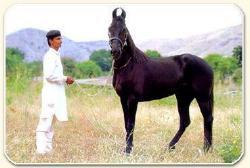 |
Historical Introduction
The call thunders down the ages through the sands of time and fades into the desert air, a haunting remembrance to an era of chivalry and valour forever lost yet indelibly stamped into the spirit of Rajasthan. To know and love the Marwari is to re-enter the magical realm of our childhood, a world of castles and heroes, intrigues and passion, dark deeds and mythical horses.
A time when women dressed as queens and queens rode like warriors, a time when men fought to live and lived to fight on the battlefields and never went gently into that good night. It is a golden opportunity to embrace the twilight world of the desert, the creative frenzy of a thousand and one festivals, and to partake in the daily rituals that help reawaken our perceptual innocence and calm our unruly souls. To know and love the Marwari is to know and love the Rajputs, for their destinies are inextricably bound. |
 |
To ride a Marwari is to realise new levels of joy that demand in turn, a receptive stillness for its appreciation. It is to view the way ahead through a pair of perfectly curved ears, gateway to the heart of India?s spiritual and ceremonial heritage.
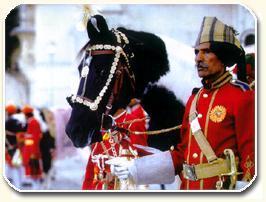
Breed Information
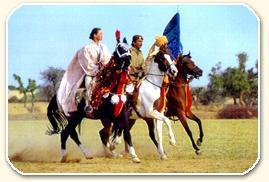 |
The Marwari horse today is descended from the splendid war horses that served the ruling families and warriors of feudal India, throughout and from the beginning of that country's history. Their status was unparalleled, as they were declared divine and superior to all men, including those of Royal blood. Accordingly, only the Rajput families and the Kshatriyas - warrior caste were permitted to mount these exalted animals. |
Today the breed is once again achieving eminence after over a century of twilight status due to the Imperial presence of the British and further, the new Indian democracy.
The Marwari horse, as the most potent symbol of the warrior Kings somehow survived wholesale slaughter, castration and fearful ignorance during the troubled times preceding Independence and for several decades later. It is thanks to the surviving Rajput families and horse lovers from all communities that the resilient and beautiful Marwari has emerged from the shadows onto a bright and hopeful future and out of the threat of extinction. |
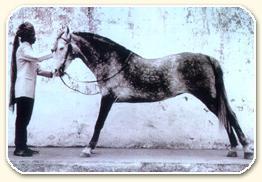 |
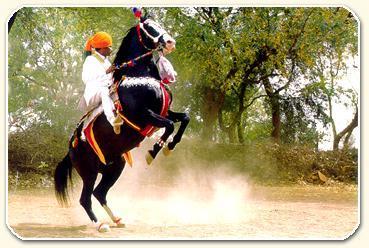
Breed Characteristics
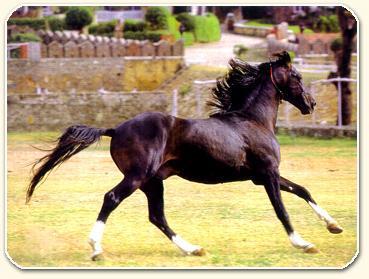
The Marwari horse stands between 14 and 17 hands depending on it's topographical origin. We have noticed that our foals and fillies are reaching higher and broader proportions by virtue of sustained and complete nutrition. But the average is probably 15 to 16 hands.
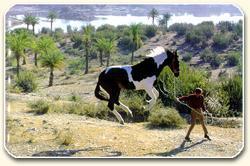 |
The Marwari comes in all colours including the boldly coloured ABLAKS - (Piebalds, red & white or Skewbalds, black & white) particularly favoured in India. The body is powerfully proportioned, compact and elegant with round rumps and muscular thighs and shoulders, making a good all round pleasure horse. |
His natural tendency to perform would make him particularly suitable for dressage. He is a tough, brave and undeniably beautiful horse who has proven his ability to adapt and thrive in most environmental conditions.
His royal history and scarcity should guarantee him a deserved status in the international equestrian arena.

The Marwari is a gaited horse with several gears. Other than posting, cantering and galloping, he engages in the REVAAL. This smooth and comfortable gait with minimal vertical movement is used in the desert to cover long distances in great comfort.
In rural Rajasthan the Marwari is commonly trained for dancing at the many festivals and marriages that occur throughout the year. This dancing is an ethnic form of haute e'cole and goes all the way back to the maneuvers of combat of previous centuries.
The natural bearing of these horses is very proud and showy with a high head carriage and a very alert appearance. The neck is beautifully arched in movement. The unique characteristic of this breed are the remarkable curled ears which form a perfect arch when pricked forward. The profile of the head is straight with a tendency to a roman nose rather than convex. The eyes are large, luminous and set wide. The coat is very fine and silky as befits a desert horse and is now known to grow denser in the colder winters of the USA.
The Indigenous Horse Society is responsible for setting and maintaining the breed standards. All the horses we buy, sell and breed at Marwari Bloodlines are subject to their high standards.
Marwari Bloodlines Dundlod, and Marwari Bloodlines Chappaquiddick, are LEFTs for information on the purchase of the Marwari horses, breed information, bloodline registration, shows, competitions and adventure horse safaris.
Marwari Bloodlines was founded by Francesca Kelly and Raghuvendra Singh in 1995 to preserve , promulgate and promote the horse in India and abroad.
